Tuesday, 27 May 2014: Narbonne to Perpignan, via Fontfroide, over the hair-raising roads of the Cathar country
Written 29 May

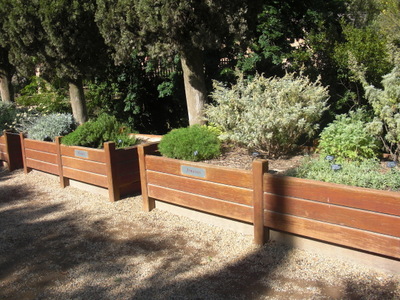 Tuesday morning, we got up promptly, checked out, and headed for the Abbaye de Fontfroide, which we planned to tour on the way to Perpignan. The GPS knew right where it was and led us there unerringly. We arrived just in time to join the 10 a.m. guided tour in French, with about four other people.
Tuesday morning, we got up promptly, checked out, and headed for the Abbaye de Fontfroide, which we planned to tour on the way to Perpignan. The GPS knew right where it was and led us there unerringly. We arrived just in time to join the 10 a.m. guided tour in French, with about four other people.
The 100-meter walk from the cashier to the point of the tour's departure, once we passed the entrance to the tasting room for the abbey's wines, was lined with these big planters displaying the abbey's medicinal and culinary herb collection. The one on the left is full of mint varieties, and those on the right "armoises" (Artemisia) and hyssops.
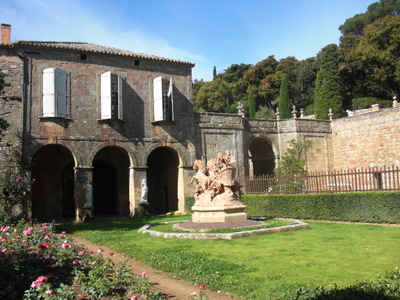
 We also passed this little fenced enclosure with a sculpture not at all in keeping with the abbey's medieval history; we speculate that it's reserved for the present owners, who actually live there. The abbey was in religious use right up until 1901, when they moved to Spain. Somebody tried to buy the place so as to take it to New York City to be part of the Cloisters there, but the present owner's family bought it instead and are still there, now in the fourth generation.
We also passed this little fenced enclosure with a sculpture not at all in keeping with the abbey's medieval history; we speculate that it's reserved for the present owners, who actually live there. The abbey was in religious use right up until 1901, when they moved to Spain. Somebody tried to buy the place so as to take it to New York City to be part of the Cloisters there, but the present owner's family bought it instead and are still there, now in the fourth generation.
Just inside the big green gate where the guide awaited us, was this entranceway courtyard (at right) Barely visible against the two uprights at the far end are stone statues of a lion dealing with a large snake and a lioness defending her cubs. The decorative urns along the right-hand wall conceal floodlights—as we've noticed many times before, the French really know how to light buildings at night.
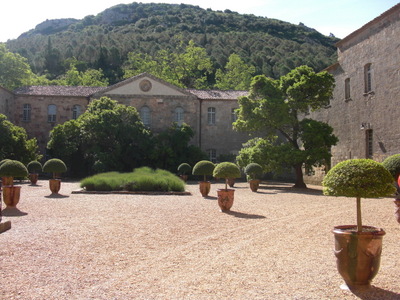
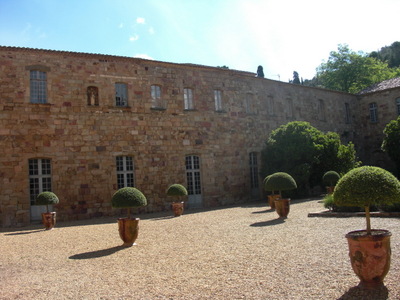 Through the door on the left was this second courtyard, surrounded by what were the monastic buildings. At its height, the abbey housed 50 to 80 monks and some hundreds of lay brothers (not all of whom actually lived inside the abbey; some lived on and ran the outlying farms). When the last monks left in 1901, they were only six.
Through the door on the left was this second courtyard, surrounded by what were the monastic buildings. At its height, the abbey housed 50 to 80 monks and some hundreds of lay brothers (not all of whom actually lived inside the abbey; some lived on and ran the outlying farms). When the last monks left in 1901, they were only six.
The second photo, at the right, shows the only corner of the courtyard where the wall is perpetually shaded; that's the only place where the original golden color of the stone can be seen. Everywhere else, it has weathered to a rough-surface gray. When asked about acid rain, the guide said he's never heard of it; they apparently don't have that problem here (lucky in their wind patterns, I guess).
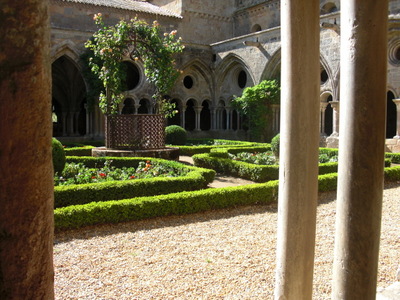
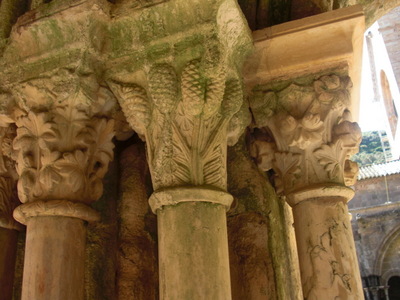 From that courtyard, we passed through a hallway with an interesting half-barrel vault ceiling and into the cloister. The double columns all the way around were made of different colors of marble, most mined locally. (In fact, Perpignan has many red and green marble sidewalks, which are beautiful but must be slippery as all get-out in the rain. We were surprised to hear that the red-and-white streaked marble came from Caunes-Miervois, northeast of Carcassonne; that's where Scott Steppan and Ann Kawamoto spent a couple of weeks, renting the house of a friend, so we had planned to drive through it for a look anyway.) Throughout the tour, the guide pointed out many modifications that have been made to the buildings since they were originally built. For example, the round ocelli above the columns were added later.
From that courtyard, we passed through a hallway with an interesting half-barrel vault ceiling and into the cloister. The double columns all the way around were made of different colors of marble, most mined locally. (In fact, Perpignan has many red and green marble sidewalks, which are beautiful but must be slippery as all get-out in the rain. We were surprised to hear that the red-and-white streaked marble came from Caunes-Miervois, northeast of Carcassonne; that's where Scott Steppan and Ann Kawamoto spent a couple of weeks, renting the house of a friend, so we had planned to drive through it for a look anyway.) Throughout the tour, the guide pointed out many modifications that have been made to the buildings since they were originally built. For example, the round ocelli above the columns were added later.
The capitals of the columns were all different and portrayed many different plant species (but, as the guide pointed out, no animals or people). The stylized reed leaf on one of them has become the universal symbol of the Cistercians (which were the order that occupied the abbey from shortly after its founding and are named for the reeds, "cistels," that grew at the site of their original monastery in Burgundy, which we visited in 2009).
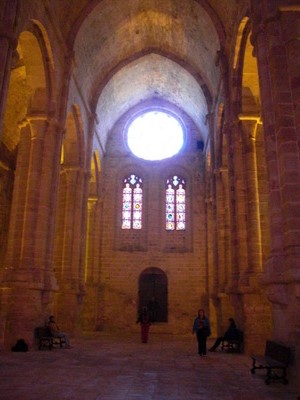
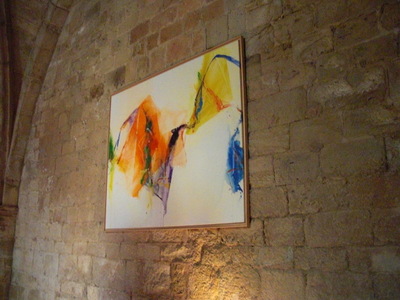 From the cloister we passed into the church itself by a side door. When the church was built, it had only two small side doors (one for the monks, who had to file in the usual six or seven times a day, including in the middle of the night, to do their Gregorian chants, and one for the lay brothers, direct from their dormatory; they apparently only attended church on Sundays and holidays); the usual large ceremonial door at the west end of the nave was missing entirely, as the Cistercians never received anyone from the outside world, so no one else was ever expected to enter the church. The guide explained, though, that the abbey is on the "small" road to Santiago de Campostelo, so eventually a small guest-house was built, where the lay brothers received travelers, and eventually, several hundred years after the church was built, a door was pierced through the west end of the nave, which you can see here, below the rose window.
From the cloister we passed into the church itself by a side door. When the church was built, it had only two small side doors (one for the monks, who had to file in the usual six or seven times a day, including in the middle of the night, to do their Gregorian chants, and one for the lay brothers, direct from their dormatory; they apparently only attended church on Sundays and holidays); the usual large ceremonial door at the west end of the nave was missing entirely, as the Cistercians never received anyone from the outside world, so no one else was ever expected to enter the church. The guide explained, though, that the abbey is on the "small" road to Santiago de Campostelo, so eventually a small guest-house was built, where the lay brothers received travelers, and eventually, several hundred years after the church was built, a door was pierced through the west end of the nave, which you can see here, below the rose window.
Written 31 May
The stained glass is all much newer than the church, only a couple of hundred years old (the church dates from the 13th century), but some of it incorporates pieces of extremely old "grisaille" windows from the original windows. In a smaller side chapel are are quite modern abstract windows created by one of the monks, who was of Korean origin. They were unphotographable, at least with the afternoon light streaming in through them, but on the opposite was was the painting shown here at the right. They looked just like that.
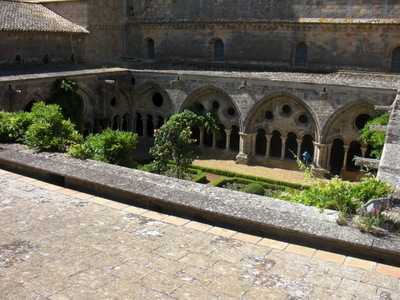
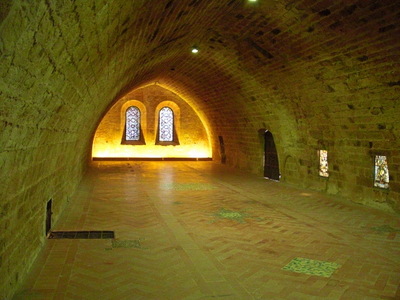 Upstairs, on the way to the lay brothers' dormitory (only one of several, because the couldn't all fit in one), we got this view down into the cloister from above.
Upstairs, on the way to the lay brothers' dormitory (only one of several, because the couldn't all fit in one), we got this view down into the cloister from above.
In this dormitory, the lay brothers slept on straw pallets, but I was glad to hear that the pallets were on wooden cots, not directly on the tiled floor. The only room in the whole abbey that was heated was the "warming room," reserved for the very elderly brothers and those who worked in the scriptorium, who were allowed to go warm up when their fingers got too stiff to write. Most of the windows shown here did not exist when the structures were built. The monks weren't intended to be able to see outside the abbey walls, and only by keeping the buildings pretty tightly closed up could they hope to keep a reasonably even temperature inside, despite the winter winds outside.
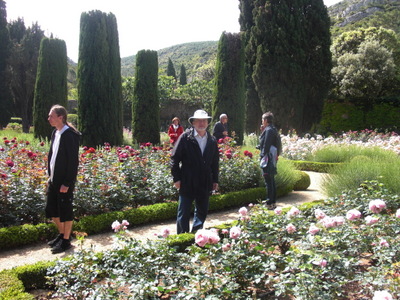
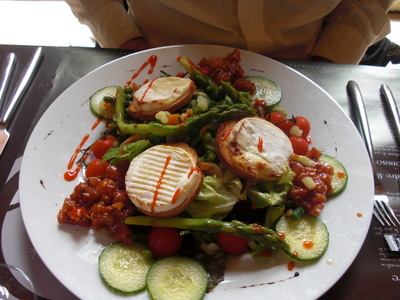 The tour ended with a turn through the rose garden—not something the monks ever had but an addition by the family that presently owns the place. They apparently have won many prizes for their roses, and the terrace gardens on the hillsides are officially designated "gardens of note." You can evey buy little potted rose bushes of the variety developed at and named for the abbey, to take home to your own garden.
The tour ended with a turn through the rose garden—not something the monks ever had but an addition by the family that presently owns the place. They apparently have won many prizes for their roses, and the terrace gardens on the hillsides are officially designated "gardens of note." You can evey buy little potted rose bushes of the variety developed at and named for the abbey, to take home to your own garden.
When the guided part of the tour ended, we backtracked to sit for a while in the beautiful nave of the church, romanesque at one end and early gothic at the other, admiring the architecture and the stained glass. The church is still "in commission," as it were, and mass is said there several times a year.
Once we'd looked again at everything along the tour route, we strolled the grounds until noon, when the restaurant on the premises opened for lunch. It must be fairly well thought of, as it claims to have been listed in the 2012 GM guide. David had the "vegetarian" salad, which promised grilled goat's cheese and lots of cooked and raw vegetables, and wow, it was the best goat-cheese salad of the trip so far. They used whole little hockey-puck-shaped goat cheese, very creamy inside (I suspect they were actual Rocadamours), and they were terrific! Plus heaps of "piperade" (stewed onions, peppers, and tomato), asparagus, tomatoes, cucumbers (which he immediately shoveled onto my plate), peas, green beans, and tiny diced cooked potato.
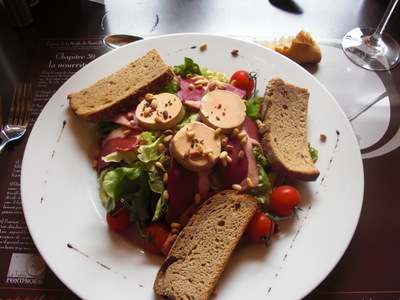
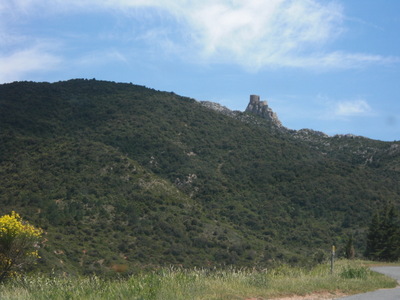 My salad, the "gourmande," featured slices of "magret" (duck ham), disks of foie gras, and pine nuts, as well as the same outstanding cherry tomatoes. Unfortunately, they thought it was a good idea to toast slices of sandwich bread rather than just using the baguette chunks they served on the side. Vanishingly little vinaigrette, but an excellent salad anyway.
My salad, the "gourmande," featured slices of "magret" (duck ham), disks of foie gras, and pine nuts, as well as the same outstanding cherry tomatoes. Unfortunately, they thought it was a good idea to toast slices of sandwich bread rather than just using the baguette chunks they served on the side. Vanishingly little vinaigrette, but an excellent salad anyway.
Posters advertised that they soon plan to initiate wine-and-tapas evenings every Thursday, with musical entertainment, featuring the abbey's wines. Hoping to draw more folks out from Narbonne, I suspect. In all, it's a pretty cool place, though not nearly so cool as Fontenay, the Cistercian abbey we toured in Burgundy in 2009 (the the trout pond, the monks' bread kitchen, and the water-wheel-driven forge).
After lunch, we set out for Perpignan, but to induce the GPS to permit a scenic route, we haphazardly chose a place in the back country, partway to Perpignan, but well away from the A9 freeway. For scenic-ness we chose well; Peyrepertuse is the site of one of the most spectacular of the Cathar castles, but for ease of driving, not so much. As we left Fontfroide, David refused the first turn the GPS recommended, as unpaved and too small, then we missed the second turn. The GPS kept recalculating and patiently showing us new routes, and we wound up spending the rest of the afternoon making a long loop way out through the countryside, past several spectacular Cathar castles, on very steep, narrow, and winding roads. At one point we came to a kilometer of 16% (!) downhill grade; I don't think that's even legal in the United States. In many other places, for miles at a time, we were in some doubt as to whether, if we met a car coming the other way, we could get past each other. One panel truck came barreling around a curve and went by us with scant inches to spare—fortunately, at that point, the sheer drop-off was on his side of the road rather than ours, so we didn't actually have heart attacks.
We saw the castles only from a distance, as they are all perched impossibly high on inaccessible crags and can be reached only by arduous hikes we weren't in the mood (or the condition) for. The one shown here could be Peyrepertuse or the Chateau de Queribus or something else again. I'm not sure.
Anyway, a very brief explanation about the Cathars (from a Greek word meaning "pure"; same root as "catharsis" and "cathartic"): They were a Christian sect in this region in the 12th and 13th centuries, and like half the religious movements of history, believed in getting back to basics. They rejected all the pomp, circumstance, mystery, and (most significantly) hierarchy of the organized church, believing that all it took to be a good Christian was to do, in all circumstances, just what Jesus would do. They believed that a good harvest resulted not from direct intervention by God but from favorable conditions and good farming practices. They practiced only one sacrament, a laying on of hands that could be performed by any member of the church, anytime, anywhere, to initiate another member of the church. They preached that everyone should try to live as Jesus did but held only those who had elected to undergo the laying on of hand to their strict rules, which included eating no meat and little fish, giving away all one's worldly goods to the poor, and, yes, life-long chastity for men and women alike. The sect could grow only by conversion.
The pope (then living in Avignon) could not stand for this kind of thing, particularly that reject-the-hierarchy bit, declared their movement a vile and intolerable heresy. He therefore started the Inquisition and launched the Albigensian Crusade (yes, a real crusade just like the ones he sent off to the holy land, named for the city of Albi, a Cathar hotbed) to exterminate them—the only Christian-on-Christian crusade ever. It took a hundred years, but they set about it systematically, starting with the massacre of the city of Béziers (that occasion was when somebody asked "how do we tell the good Christians from the bad ones?" and was told (by the Papal legate, I think), "Kill them all; God will recognize his own").
The Cathars, who had no military capability, eventually retreated into the hills and took up residence in old defensive castles on the hilltops (I had thought that the Cathars built the castles, but David says that, no, the castles were already there, abandonned; a hundred years earlier, they had lined the national border, but the border had moved, and rendering them obsolete). The castles were pretty impregnable, but the crusaders just surrounded them and starved the Cathars out. They never did surrender and perished in place, to a man (and woman). Any who were captured outside the castles were given the choice between conversion to standard Catholicism and being burned at the stake; almost all chose the stake.
Once we got to Peyrepertuse, we reset the GPS for the Ibis Budget Centre Mediterran&;eacute;e in Perpignan, which it insisted was an unreachable location, but it proceeded at least to take us toward it. From that point on, the roads got better; some were even so wide they had lines painted down the center. All the hoards of tourists that drive up to look at the castles come from the Narbonne/Perpignan side and not from the far back country we wound up approaching from. But it was still all unbelievably picturesque.
Once we finally reached Perpignan, sure enough, you couldn't reach the hotel by car. The Espace Méditerranée turns out to be a large pedestrian plaza surrounded by apartment buildings, office buildings, and hotels, of which ours was one. So drove past it, let the GPS steer us around the block, and dove into the commercial parking garage under the plaza. It was one of those that (a) has itty-bitty parking spaces and puts a pillar every two cars and (b) has a freshly rubberized floor that squeaks piercingly whenever you turn the wheel while you reach and maneuver into a space. It took three back-and-fills (jeeters, muy mother would have called them) to get our car into the space, and then we were so close to the pillar on one side and the car on the other that we had to to back halfway out to get our stuff out of the back seat. And it wasn't cheap, but it was certainly convenient. We found the elevator up and trundled our luggage over to our Ibis Budget.
Dinner was at La Galinette, only a few blocks away. A galinette is a fish (Atherina boyeri, which rejoices in, or perhaps labors under, the English name "tub gurnard"; it's much prettier than the name suggests).
Written 2 June
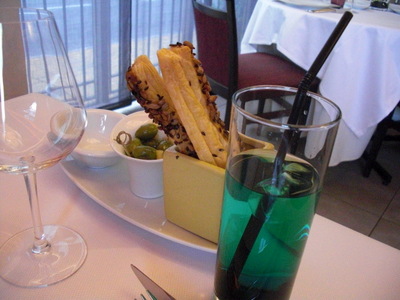
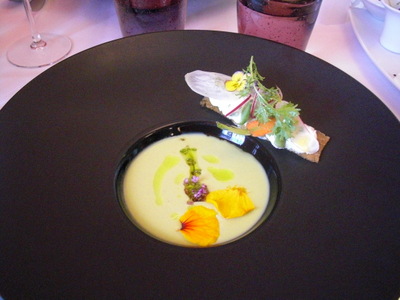 We ordered the set menu, so we both ate the same things. The first amuse-bouche, served with David's introductory glass of champagne (and my mint syrup and water) was a little dish of exceptionally slippery olives (and annoyingly blunt pics attempt to spear them with) and tall stips of crisp puff pastry topped with sunflower and flax seeds.
We ordered the set menu, so we both ate the same things. The first amuse-bouche, served with David's introductory glass of champagne (and my mint syrup and water) was a little dish of exceptionally slippery olives (and annoyingly blunt pics attempt to spear them with) and tall stips of crisp puff pastry topped with sunflower and flax seeds.
Second amuse bouche: a cold puréed soup of young fava beans drizzled with oil amd topped with flower petals and a sprig of what the waiter tried to tell us was parsley flowers (he was a way better sommelier than botanist; it was actully thyme). On the edge, a thin crispy strip of toast spread with "brousse de brebis" (sheep's milk curds) seasoned with salt and chives and topped with a whole assortment of paper-thin veggie slices, a little pansy, and a mizuna leaf. (Right on the menu, the chef warns diners "J'adore le végétale!" He's apparently a gung-ho gardener.)
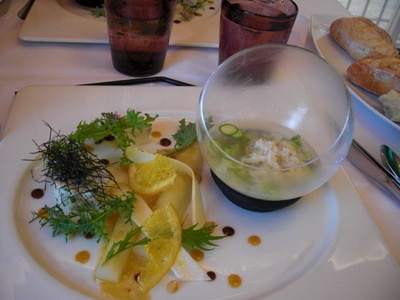
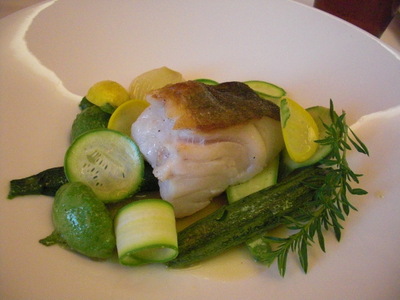 First course: "Tourteaux" crab two ways. In the glass globe, tartare of crab shreds with bits of leek and thin cross-sections of asparagus. At the table, the waiter poured hot dashi broth over it to "cook" the crab. On the plate, two cooked spears of white asparagus topped with paper-thin longitudinal slices of raw white asparagus, in turn topped with sweetened and toasted lemon slices. Under the thatch of dried seaweed threads is a little cylinder of seasoned cooked crab shreds. A couple of little cubes of dashi jelly. The colorful dots are purées and syrups of various citrus fruits. Delicious.
First course: "Tourteaux" crab two ways. In the glass globe, tartare of crab shreds with bits of leek and thin cross-sections of asparagus. At the table, the waiter poured hot dashi broth over it to "cook" the crab. On the plate, two cooked spears of white asparagus topped with paper-thin longitudinal slices of raw white asparagus, in turn topped with sweetened and toasted lemon slices. Under the thatch of dried seaweed threads is a little cylinder of seasoned cooked crab shreds. A couple of little cubes of dashi jelly. The colorful dots are purées and syrups of various citrus fruits. Delicious.
First main course: Slab of outstanding roasted cod with an assortment of raw and cooked baby zucchini from the chef's garden—long ones, round ones, cooked and raw, even a little green patty-pan-shaped one. Under it all, half a cooked spring onion. The herb sprig was "sarriette," summer savory.

 Second main course: "pagre" (Pagrus pagrus, red porgy, common seabream), with an assortment of baby carrots, carrot purée, and a crisp, deep-fried, frond of carrot top. Very different in flavor and texture from the cod, but also delicious.
Second main course: "pagre" (Pagrus pagrus, red porgy, common seabream), with an assortment of baby carrots, carrot purée, and a crisp, deep-fried, frond of carrot top. Very different in flavor and texture from the cod, but also delicious.
Predessert: A play on exotic fruits. At the left, a soft coconut macaroon topped with stewed caramelized pineapple and (viewed almost edgewise) a paperthin toasted pineapple slice. In the glass, a panna cotta topped with mango-passionfruit purée and a few passionfruit seeds. In front, a comet of mango purée. At the right, a quenelle of tropical fruit sorbet (resting on an insulating bed of cookie crumbs to retard melting).
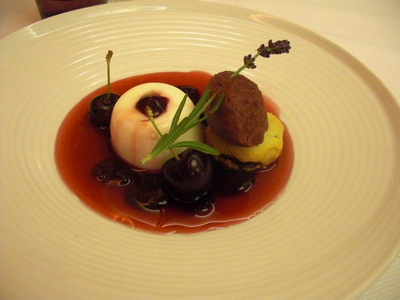 Dessert: A play on "Burlat" black cherries, in season just now. A little clafouti, topped with a quenelle of cherry sorbet. Cooked and raw cherries in cherry juice, and a sort of vanilla custart topped with cherry jam.
Dessert: A play on "Burlat" black cherries, in season just now. A little clafouti, topped with a quenelle of cherry sorbet. Cooked and raw cherries in cherry juice, and a sort of vanilla custart topped with cherry jam.
A very nice dinner altogether. Now I just have to remember, first thing in the morning, to go on line and reserve a table at db Bistro Moderne in New York City for our trip there with Martha. That's the earliest they'll accept reservations for our date.
previous entry
List of Entries
next entry

 Tuesday morning, we got up promptly, checked out, and headed for the Abbaye de Fontfroide, which we planned to tour on the way to Perpignan. The GPS knew right where it was and led us there unerringly. We arrived just in time to join the 10 a.m. guided tour in French, with about four other people.
Tuesday morning, we got up promptly, checked out, and headed for the Abbaye de Fontfroide, which we planned to tour on the way to Perpignan. The GPS knew right where it was and led us there unerringly. We arrived just in time to join the 10 a.m. guided tour in French, with about four other people.
 We also passed this little fenced enclosure with a sculpture not at all in keeping with the abbey's medieval history; we speculate that it's reserved for the present owners, who actually live there. The abbey was in religious use right up until 1901, when they moved to Spain. Somebody tried to buy the place so as to take it to New York City to be part of the Cloisters there, but the present owner's family bought it instead and are still there, now in the fourth generation.
We also passed this little fenced enclosure with a sculpture not at all in keeping with the abbey's medieval history; we speculate that it's reserved for the present owners, who actually live there. The abbey was in religious use right up until 1901, when they moved to Spain. Somebody tried to buy the place so as to take it to New York City to be part of the Cloisters there, but the present owner's family bought it instead and are still there, now in the fourth generation.
 Through the door on the left was this second courtyard, surrounded by what were the monastic buildings. At its height, the abbey housed 50 to 80 monks and some hundreds of lay brothers (not all of whom actually lived inside the abbey; some lived on and ran the outlying farms). When the last monks left in 1901, they were only six.
Through the door on the left was this second courtyard, surrounded by what were the monastic buildings. At its height, the abbey housed 50 to 80 monks and some hundreds of lay brothers (not all of whom actually lived inside the abbey; some lived on and ran the outlying farms). When the last monks left in 1901, they were only six.
 From that courtyard, we passed through a hallway with an interesting half-barrel vault ceiling and into the cloister. The double columns all the way around were made of different colors of marble, most mined locally. (In fact, Perpignan has many red and green marble sidewalks, which are beautiful but must be slippery as all get-out in the rain. We were surprised to hear that the red-and-white streaked marble came from Caunes-Miervois, northeast of Carcassonne; that's where Scott Steppan and Ann Kawamoto spent a couple of weeks, renting the house of a friend, so we had planned to drive through it for a look anyway.) Throughout the tour, the guide pointed out many modifications that have been made to the buildings since they were originally built. For example, the round ocelli above the columns were added later.
From that courtyard, we passed through a hallway with an interesting half-barrel vault ceiling and into the cloister. The double columns all the way around were made of different colors of marble, most mined locally. (In fact, Perpignan has many red and green marble sidewalks, which are beautiful but must be slippery as all get-out in the rain. We were surprised to hear that the red-and-white streaked marble came from Caunes-Miervois, northeast of Carcassonne; that's where Scott Steppan and Ann Kawamoto spent a couple of weeks, renting the house of a friend, so we had planned to drive through it for a look anyway.) Throughout the tour, the guide pointed out many modifications that have been made to the buildings since they were originally built. For example, the round ocelli above the columns were added later.
 From the cloister we passed into the church itself by a side door. When the church was built, it had only two small side doors (one for the monks, who had to file in the usual six or seven times a day, including in the middle of the night, to do their Gregorian chants, and one for the lay brothers, direct from their dormatory; they apparently only attended church on Sundays and holidays); the usual large ceremonial door at the west end of the nave was missing entirely, as the Cistercians never received anyone from the outside world, so no one else was ever expected to enter the church. The guide explained, though, that the abbey is on the "small" road to Santiago de Campostelo, so eventually a small guest-house was built, where the lay brothers received travelers, and eventually, several hundred years after the church was built, a door was pierced through the west end of the nave, which you can see here, below the rose window.
From the cloister we passed into the church itself by a side door. When the church was built, it had only two small side doors (one for the monks, who had to file in the usual six or seven times a day, including in the middle of the night, to do their Gregorian chants, and one for the lay brothers, direct from their dormatory; they apparently only attended church on Sundays and holidays); the usual large ceremonial door at the west end of the nave was missing entirely, as the Cistercians never received anyone from the outside world, so no one else was ever expected to enter the church. The guide explained, though, that the abbey is on the "small" road to Santiago de Campostelo, so eventually a small guest-house was built, where the lay brothers received travelers, and eventually, several hundred years after the church was built, a door was pierced through the west end of the nave, which you can see here, below the rose window.
 Upstairs, on the way to the lay brothers' dormitory (only one of several, because the couldn't all fit in one), we got this view down into the cloister from above.
Upstairs, on the way to the lay brothers' dormitory (only one of several, because the couldn't all fit in one), we got this view down into the cloister from above.
 The tour ended with a turn through the rose garden—not something the monks ever had but an addition by the family that presently owns the place. They apparently have won many prizes for their roses, and the terrace gardens on the hillsides are officially designated "gardens of note." You can evey buy little potted rose bushes of the variety developed at and named for the abbey, to take home to your own garden.
The tour ended with a turn through the rose garden—not something the monks ever had but an addition by the family that presently owns the place. They apparently have won many prizes for their roses, and the terrace gardens on the hillsides are officially designated "gardens of note." You can evey buy little potted rose bushes of the variety developed at and named for the abbey, to take home to your own garden.
 My salad, the "gourmande," featured slices of "magret" (duck ham), disks of foie gras, and pine nuts, as well as the same outstanding cherry tomatoes. Unfortunately, they thought it was a good idea to toast slices of sandwich bread rather than just using the baguette chunks they served on the side. Vanishingly little vinaigrette, but an excellent salad anyway.
My salad, the "gourmande," featured slices of "magret" (duck ham), disks of foie gras, and pine nuts, as well as the same outstanding cherry tomatoes. Unfortunately, they thought it was a good idea to toast slices of sandwich bread rather than just using the baguette chunks they served on the side. Vanishingly little vinaigrette, but an excellent salad anyway.
 We ordered the set menu, so we both ate the same things. The first amuse-bouche, served with David's introductory glass of champagne (and my mint syrup and water) was a little dish of exceptionally slippery olives (and annoyingly blunt pics attempt to spear them with) and tall stips of crisp puff pastry topped with sunflower and flax seeds.
We ordered the set menu, so we both ate the same things. The first amuse-bouche, served with David's introductory glass of champagne (and my mint syrup and water) was a little dish of exceptionally slippery olives (and annoyingly blunt pics attempt to spear them with) and tall stips of crisp puff pastry topped with sunflower and flax seeds.
 First course: "Tourteaux" crab two ways. In the glass globe, tartare of crab shreds with bits of leek and thin cross-sections of asparagus. At the table, the waiter poured hot dashi broth over it to "cook" the crab. On the plate, two cooked spears of white asparagus topped with paper-thin longitudinal slices of raw white asparagus, in turn topped with sweetened and toasted lemon slices. Under the thatch of dried seaweed threads is a little cylinder of seasoned cooked crab shreds. A couple of little cubes of dashi jelly. The colorful dots are purées and syrups of various citrus fruits. Delicious.
First course: "Tourteaux" crab two ways. In the glass globe, tartare of crab shreds with bits of leek and thin cross-sections of asparagus. At the table, the waiter poured hot dashi broth over it to "cook" the crab. On the plate, two cooked spears of white asparagus topped with paper-thin longitudinal slices of raw white asparagus, in turn topped with sweetened and toasted lemon slices. Under the thatch of dried seaweed threads is a little cylinder of seasoned cooked crab shreds. A couple of little cubes of dashi jelly. The colorful dots are purées and syrups of various citrus fruits. Delicious.
 Second main course: "pagre" (Pagrus pagrus, red porgy, common seabream), with an assortment of baby carrots, carrot purée, and a crisp, deep-fried, frond of carrot top. Very different in flavor and texture from the cod, but also delicious.
Second main course: "pagre" (Pagrus pagrus, red porgy, common seabream), with an assortment of baby carrots, carrot purée, and a crisp, deep-fried, frond of carrot top. Very different in flavor and texture from the cod, but also delicious. Dessert: A play on "Burlat" black cherries, in season just now. A little clafouti, topped with a quenelle of cherry sorbet. Cooked and raw cherries in cherry juice, and a sort of vanilla custart topped with cherry jam.
Dessert: A play on "Burlat" black cherries, in season just now. A little clafouti, topped with a quenelle of cherry sorbet. Cooked and raw cherries in cherry juice, and a sort of vanilla custart topped with cherry jam.